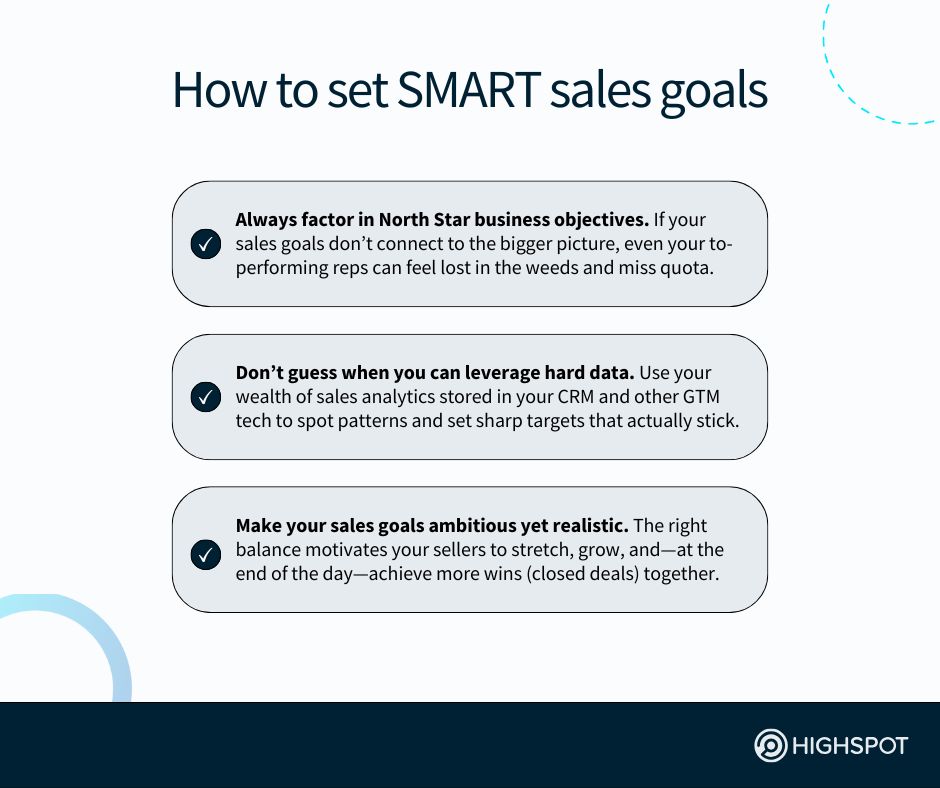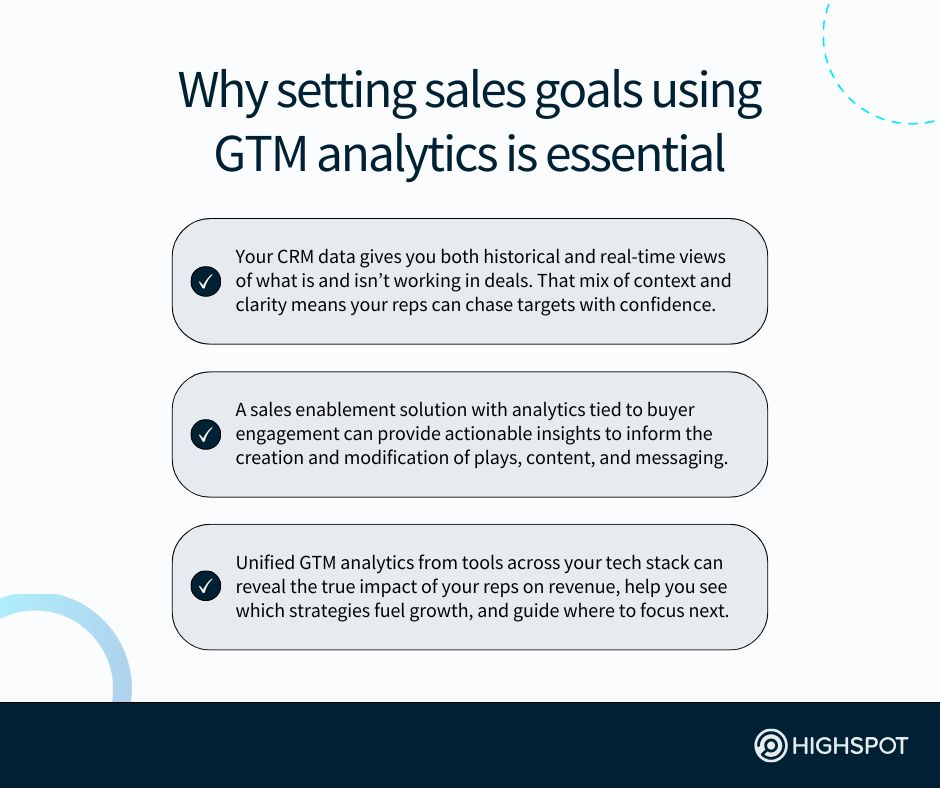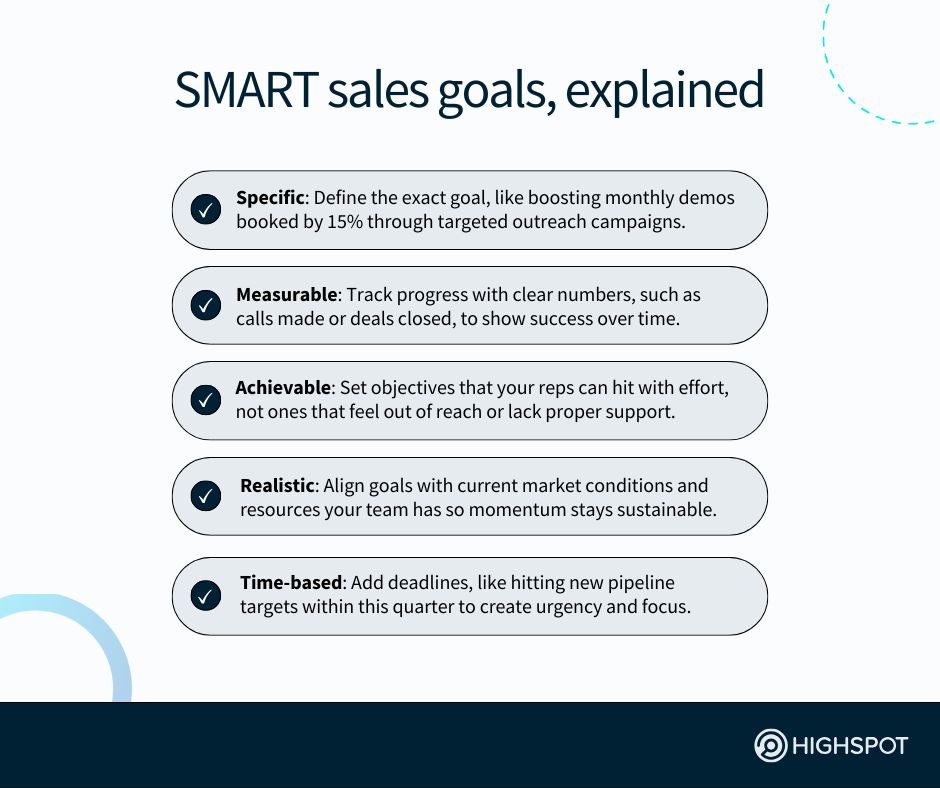Key Takeaways
- Create sales goals and objectives for your reps that fuel real momentum. From top-line targets to team habits, setting targets that move the needle without adding busywork to the mix is essential.
- Monthly sales goals work best when everyone’s synced. Set stretch goals that are lofty but achievable and based on your wealth of go-to-market (GTM) performance data to align your team, build focus, and keep everyone on the same page, from kickoff to close.
- Setting SMART sales goals, in particular, can help you effectively track rep progress over time, as you can easily measure what matters and give your GTM strategy the clarity it’s been missing.
Many B2B sales leaders focus on getting their reps to sell as much as possible. The quality of customer engagement is important to them, but not as much as hitting key revenue targets laid out by leadership for the fiscal year.
That mindset alone, though, isn’t enough to achieve long-term sales success. It’s too broad, vague, and fails to drive real progress. It’s also likely to cause substantial burnout (and possibly voluntary attrition) across your sales team.
Simply put, the most effective sales goals and objectives set by go-to-market leaders like you today must be clear, actionable, and aligned with the big picture.
“Leaders today are expected to deliver precision, scale, and impact, often with less time, tighter resources, and higher expectations,” Highspot’s GTM Performance Gap Report explains. “But that level of performance doesn’t come from adding more tools or hoping AI will do the heavy lifting.
“It comes from building systems that connect strategy to action, align every team around a shared goal, and give sellers the clarity to move fast with purpose.”
With that in mind, let’s explore what it takes to align your GTM teams around a shared vision that helps you achieve customer acquisition goals; gain greater market share, and help your sales, enablement, and marketing teams work smarter.

What are sales goals?
Sales goals are clear, measurable targets that help your revenue team stay focused and aligned around what matters most. They’re typically set by sales managers and other GTM leaders looking to drive performance across reps, regions, and segments.
Effective sales goals are tied to key sales metrics like win rate, deal velocity, and pipeline coverage, not just sales quotas. They should also account for business goals set by your C-suite, ensuring sales execution ladders up to broader company strategy.
Your organisation’s sales objectives define what you want to achieve, while sales goals define how and when you’ll do it. Great goals help you track progress of the entire sales team, spot roadblocks early, and coach reps to consistently strong performance.
You can define sales goals at any level. For example, you get create ones team-wide, by segment, or for individual sellers. Similarly, you can set ones tied to specific sales activities, the volume of discovery calls and sales follow-up emails sent, and broader go-to-market initiatives, such as new product launches.
The purpose of setting data-backed sales goals is to ultimately create accountability among your sales personnel and other GTM teams (notably, marketing and enablement) and drive targeted improvement with meeting revenue targets.
The most effective go-to-market strategies today are designed around sales goals that are ambitious but realistic, so they push reps without setting them up to fail.
| Stakeholder involved in setting sales goals | What they want to achieve |
|---|---|
| Chief Executive Officer | Ensure all sales reps hit revenue goals by aligning go-to-market teams around clear sales targets that directly influence total revenue generated and the overall business strategy. |
| Chief Revenue Officer | Optimise the sales process to increase the number of customers while ensuring GTM functions work together to drive new customers and maximise revenue potential across the board. |
| Chief Sales Officer | Create accountability across regions and roles by translating sales goals into tactics and quotas that help managers and reps execute the appropriate sales strategies and drive performance. |
| Chief Marketing Officer | Align sales and marketing around goals focused on lead gen, tying campaigns to sales pipeline growth, and improving handoff between the two teams for better conversion outcomes. |
| Director of Sales Operations | Enable smarter forecasting so they can set data-informed goals that map granular sales activities to higher-level targets and help connect sellers’ execution to business-level metrics. |
| Director of Revenue Operations | Build cohesive cross-functional programmes that ensure sales reps and GTM teams hit targets while contributing to growth, efficiency, and improved insights across the full funnel. |
| Director of Customer Success | Establish post-sale sales goals focused on improving customer retention and NPS, growing existing accounts, and increasing the lifetime value of each sales rep’s book of business. |
| Sales Managers | Motivate teams by creating sales goals tailored to each sales rep that are tied to their performance, helping them stay focused, accountable, and aligned to team and company objectives. |
SMART sales goals to set for your team
To work, sales goals must be intelligent. That means backed by rich insights from sales management dashboards in tools across your GTM tech ecosystem. Otherwise, they’re just wishful thinking. That’s where SMART goals help.
Today’s top revenue and other GTM leaders ensure their sales goals are:
- Specific: Set a clear plan to grow future sales. Don’t just aim to grow your customer base or increase your revenue. Explain how you plan to accomplish goals. For example, “We’re going to increase annual revenue from our core product by 20% through a consultative sales approach.”
- Measurable: Define what success looks like. If you aim to increase revenue by $1M, set up tracking in your GTM solutions—notably, your CRM system—to monitor progress, when it comes to boosting sales, through metrics like closed deals, repeat purchases, and customer retention. This way, you can benchmark your performance and not just hope for strong results.
- Achievable: As noted, balancing ambition with what’s realistic is best. If last year’s revenue was $500K, a target of $2M might demotivate your sales department rather than inspire them to build more potential-customer relationships. Instead, set a stretch goal that feels within reach, like a $300K increase in annual sales, so the team buys in and is committed to your vision.
- Realistic: Goals need to align with your current business situation and sales organisation’s strategy as well as external market conditions. Customer acquisition is always toughest in difficult economic climates, so account for macro data along with internal performance KPIs and closed-won figures to ensure your sales and revenue goals are actually feasible.
- Time-based: When setting sales goals, you must define a finish line. Otherwise, you can wind up plodding on for years without much change or growth. Set quarterly or annual targets to keep everyone focused and accountable. These time-bound markers also align with fiscal periods, making it easier to measure progress consistently.
As business consultant Scott Edinger recently wrote for Harvard Business Review, you can easily discern whether your SMART sales goals are being met not only by looking at recent and historical customer data tied to the conversion of qualified leads but also day-to-day data tied to reps’ sales activities.
“Every sales call reflects the success or failure of your strategy,” Scott wrote. “It can become a massive accumulation of wins—or death by a thousand cuts.”
Scott’s advice? “Look at what’s happening with the sales team—and the individual goals they’re pursuing—as the symptom when deals fail to produce an acceptable margin, when opportunities are too small to produce meaningful revenue, or when market share in a segment is lower than you expect or want.”
This data will give you insights needed to know whether you should adjust your goals (and pivot your GTM strategy) or stick with these agreed-upon targets.
The Highspot team discusses what it takes for go-to-market teams to align around shared revenue and business goals so they can collaborate successfully with one another.
Benefits of data-driven sales goals
Setting structured sales goals is like using Google Maps for your business growth. Your desired destination is clear, and, with the SMART-goal framework, you can plan the best route and gauge your arrival time (read: forecast sales).
All in all, SMART sales goals can make a massive difference, as they:
- Encourage teamwork: Clear goals give everyone a shared destination. When everyone knows what they’re working toward, collaboration improves, and individual efforts align with the overall objectives. Goal clarity and self-management can vastly improve team performance.
- Create learning opportunities: Sales goals highlight areas for skill development, helping sales reps learn and grow as they work toward their targets. According to the American Psychological Association, engaging employees in organisational goals fosters enthusiasm and commitment, which supports personal growth and boosts job satisfaction. This creates a more motivated team and a healthier workplace.
- Trigger process improvement: Well-defined goals can reveal gaps in your current processes so that you can refine workflows. For instance, a SMART goal to “reduce lead response time by 20%” might highlight bottlenecks in communication, prompting a more streamlined handoff process between BDRs and AEs.
- Help create accurate forecasts: Sales leaders can predict outcomes more accurately with SMART goals. This clarity helps them track progress, spot trends, and make smarter planning and budgeting decisions.. helps in budgeting and planning efforts.
- Improve customer acquisition and retention: SMART sales goals guide efforts to strengthen relationships with existing customers while attracting new ones. With clear targets, sales reps can tailor their approach to meet customer needs more effectively, resulting in a positive experience.
You may not realise these advantages in the weeks after setting sales team goals using this framework. But it’s clear this approach yields major dividends for companies that lean on quantitative data and qualitative insights from reps to continually alter their approaches to close deals and acquire customers
How GTM leaders can create sales goals
Now that you know what makes the best sales goal, it’s time to craft some for your team. Consider areas for improvement, practicality, SMART criteria, and enablement to ensure your goals are viable and aligned with the resources available.
Identify areas of improvement with sales professionals
Start the goal-setting process by digging into sales performance to identify the real issues. Look closely at team metrics and pinpoint each rep’s challenges:
- Review key performance indicators (KPIs): Analyse metrics that matter most to your team, like conversion rates or average deal size.
- Assess performance gaps: Conduct a skills audit to pinpoint where top and bottom performers differ. For example, if top performers excel at closing techniques, consider hosting targeted coaching focusing on that skill or pair sales reps needing a boost in a particular skill with another team member for mentorship.
- Identify sales cycle drop-offs: Look for stages where leads tend to fall through the cracks or deals are lost. This insight can reveal critical points for improvement.
- Uncover root causes of underperformance: Look beyond the surface. Underperformance stems from factors like training needs, misaligned incentives, or process bottlenecks.
The more precise your understanding of these improvement opportunities, the better your position to set specific, actionable goals that address your team’s unique challenges.
Decide on reasonable targets for your sales objectives
Now that you’ve chosen a KPI to focus on, set a target your team can realistically achieve. This step involves setting a measurable, clear objective that doesn’t stretch too far beyond current performance but also pushes your team to grow. Here’s what to consider:
- Choose a measurable metric: Decide if you’ll use a percentage increase (15%) or a specific number (10 new leads).
- Set a realistic target number: Based on past performance, determine a challenging yet achievable target (growing revenue by $20,000 or boosting conversion rates by 10%).
- Define your timeline: Outline a time frame that matches the goal’s complexity, whether one month, one quarter, or more. This gives your team a clear runway to work toward.
If the gap from current performance to the goal feels too wide, set incremental milestones to keep the sales team motivated. Smaller wins will build momentum without overwhelming the team.
Educate and enable your sales team members constantly
Finally, don’t forget to empower your team. Sales goals are more likely to succeed when everyone has the resources and skills to achieve them. In fact, organisations that use data-driven enablement strategies are more likely to improve sales efficiency. Here’s how to make that happen:
- Equip sales with training resources: Provide learning materials, workshops, and coaching sessions focused on the skills and strategies to help them hit quotas and build relationships with prospects. A sales enablement platform can streamline this process, making resources easily accessible for your team.
- Leverage revenue enablement: Arm the entire revenue team with the right resources to support client relationships. Organisations focused on revenue enablement are at least 75% more likely to exceed performance targets such as seller revenue, cross-sell/upsell, and revenue growth.
- Celebrate wins along the way: As your team reaches milestones, even the small ones, recognise and celebrate them to keep momentum and morale high.
By setting structured goals and actively supporting your team, you create a culture where success is a repeatable process.

15 sales goal examples for B2B companies
Sales teams have lots of possibilities when it comes to setting sales targets. You have to find what’s right for your team and industry. Looking for a bit of inspiration? Here’s a list of some popular sales goals to kickstart your planning.
1. Increase sales revenue
- Sales goal example: Grow monthly revenue 15% by upselling existing customers on higher-tier solutions using value-based messaging.
- Why it matters: Revenue growth reflects the health of your sales strategy and helps sustain long-term business momentum.
Revenue is the scoreboard your execs check first thing in the morning. Set goals that pump up the bottom line by moving more products, winning bigger deals, or simply selling smarter. The key? Keep it bold but achievable—stretch enough to inspire, without snapping your team’s motivation.
2. Close more deals
- Sales goal example: Increase close rate 10% this quarter by standardising discovery questions and improving objection handling in demos.
- Why it matters: Closing more deals improves efficiency, boosts team confidence, and accelerates revenue generation consistently.
Chasing more prospects is sometimes the answer. Ideally, though, your reps are more focused about turning the right leads into new customers. Closing more deals means refining discovery, handling objections like a pro, and always keeping follow-up tight. When your team nails this, the wins start stacking up.
3. Boost booking rate
- Sales goal example: Raise booking rate 12% by tightening follow-up cadences and using automated reminders for inbound leads each week.
- Why it matters: A higher booking rate fills the pipeline faster and ensures reps maximise time with qualified opportunities.
A packed calendar is a healthy pipeline’s heartbeat. Improving booking rate means fewer no-shows, more confirmed meetings, and conversations that actually matter. Nail this goal, and you’ll transform polite interest into face-to-face momentum that moves prospects down the funnel faster.
4. Boost the number of cold calls
- Sales goal example: Make 20% more cold calls per rep by scheduling two daily prospecting power hours dedicated solely to outbound outreach.
- Why it matters: More cold calls create more conversations, expand reach, and increase the chance of uncovering quality leads.
Love them or hate them, cold calls are still a sales classic. Setting a goal here helps build discipline and consistency, even when rejection’s part of the game. Done right, more dials mean more doors opened—and more chances to surprise buyers with real value.
5. Increase qualified leads
- Sales goal example: Drive 25% more qualified leads by refining lead scoring models and aligning with marketing on targeted campaigns.
- Why it matters: Better qualified leads reduce wasted effort, shorten sales cycles, and increase conversion rates across the funnel.
Forget chasing random names—you want leads that actually belong in your funnel. This goal is all about quality over quantity, making sure your reps spend time on prospects who can really buy. The result? A sales pipeline that’s lean, mean, and bursting with potential.
6. Increase average deal size
- Sales goal example: Raise average deal size 15% by bundling complementary services and training reps to highlight full-solution packages.
- Why it matters: Bigger deal sizes strengthen revenue per customer and maximise the value of each successful sales interaction.
More revenue without more deals? Yes, please. Raising average deal size pushes your team to upsell, cross-sell, and expand existing accounts. Think of it like upgrading from coach to first class—it’s the same seat, but with way more value.
7. Reduce customer churn
- Sales goal example: Lower churn rate 10% this quarter by implementing quarterly success check-ins and offering proactive renewal incentives.
- Why it matters: Retaining customers costs less than acquiring new ones and ensures ongoing revenue from established relationships.
Landing customers is hard; keeping them is priceless. Reducing churn means digging into why clients leave and fixing it before they walk out the door. Set this goal, and your revenue curve won’t just rise—it’ll stay steady, sticky, and sustainable.
8. Increase customer lifetime value (CLV)
- Sales goal example: Lift CLV 20% by expanding customer success programmes that encourage upsells, renewals, and cross-selling opportunities.
- Why it matters: A higher CLV creates predictable revenue streams and helps maximise profitability from existing customers.
Your LV is the measure of how much a customer’s worth over the long haul, not just one purchase. Growing this number means making every customer relationship a marathon, not a sprint. With strong retention and upsell strategies, every deal is just the beginning of a bigger story.
9. Lower customer acquisition costs (CAC)
- Sales goal example: Cut CAC 15% by optimising digital ad spend and strengthening referral programmes that generate lower-cost opportunities.
- Why it matters: Reducing CAC improves overall profit margins and enables your team to reinvest more in growth initiatives.
Spending big to win a customer makes no sense if margins disappear. Lowering CAC means tightening your sales process, sharpening targeting, and making every dollar work harder. The endgame? A leaner, more efficient growth machine that delivers maximum ROI.

10. Shorten time to close
- Sales goal example: Reduce time to close by 5 days by automating proposal generation and giving reps pre-approved contract templates.
- Why it matters: Faster closes improve pipeline velocity, allow more deals per rep, and create a stronger competitive advantage.
Time kills deals. Shaving days—or weeks—off the sales cycle helps reps win more often while keeping prospects warm and engaged. When you set this goal, you’re not just closing faster—you’re creating momentum that builds a healthier, speedier pipeline.
11. Increase sales email response rate
- Sales goal example: Boost response rate 12% by A/B testing subject lines and personalising email content for each priority prospect list.
- Why it matters: Higher response rates open more conversations, improve engagement, and lead to greater conversion potential.
An inbox full of crickets helps no one. Increasing response rates means writing emails that buyers actually want to open, read, and reply to. Think sharper subject lines, tailored value props, and crisp calls-to-action that make “delete” the last option on the table.
12. Speed up lead response time
- Sales goal example: Cut lead response time to under 10 minutes by setting up instant routing rules and automated Slack alerts for reps.
- Why it matters: Faster responses capture buyer attention early and significantly increase the chance of winning the deal.
When a lead raises their hand, speed is everything. Every minute you wait, their interest cools and your competition heats up. This goal turns “We’ll get back to you” into “We’re already here,” earning you instant credibility and first-mover advantage.
13. Deepen buyer engagement
- Sales goal example: Increase engagement 20% by sharing tailored content and setting clear follow-up tasks within each sales interaction.
- Why it matters: Engaged buyers move through the funnel faster, build trust with reps, and are more likely to commit to purchase.
Engagement is the difference between polite nods and actual momentum. Setting this goal means driving more content views, meeting participation, and meaningful back-and-forth with prospects. The deeper the engagement, the easier it is to move deals across the finish line.
14. Improve Net Promoter Score (NPS)
- Sales goal example: Raise NPS by 10 points by gathering real-time feedback and training reps to respond quickly to customer concerns.
- Why it matters: A higher NPS signals strong customer satisfaction and often leads to referrals and repeat business growth.
Your NPS surveys are a window into customer love. Improving it means creating experiences that make people not just satisfied, but evangelical. Nail this goal, and your customers will become your loudest, most persuasive marketing channel.
15. Increase market share
- Sales goal example: Capture 5% more market share by entering a new vertical segment and tailoring messaging for industry-specific needs.
- Why it matters: Expanding market share strengthens brand authority, drives sustainable growth, and positions you above competitors.
Market share is bragging rights with a balance sheet. The more you own, the harder it is for competitors to catch up. Setting this goal inspires teams to play big, outpace rivals, and claim their place as the category’s go-to.




